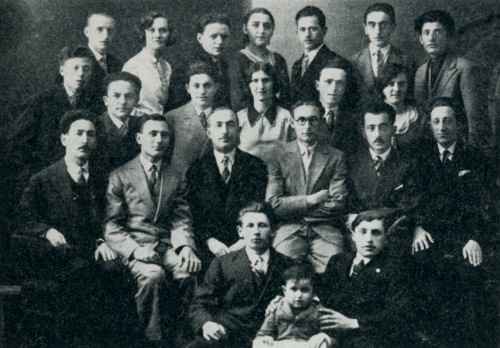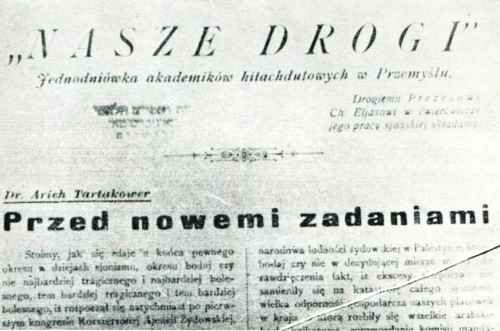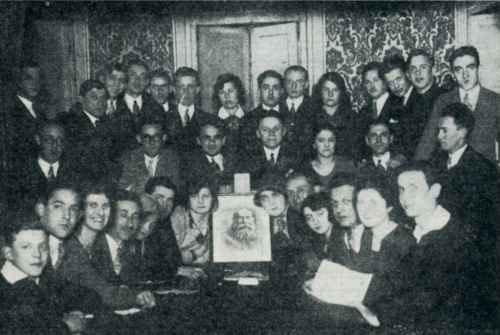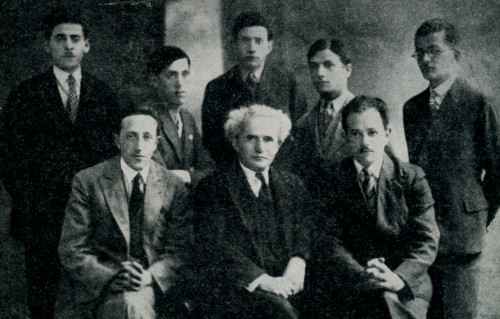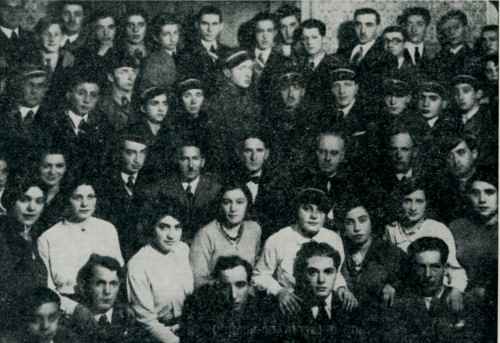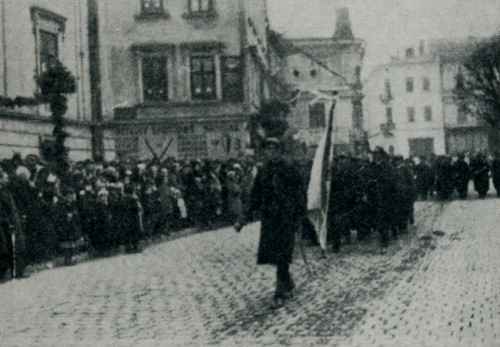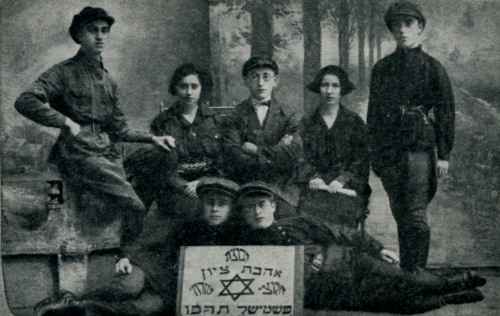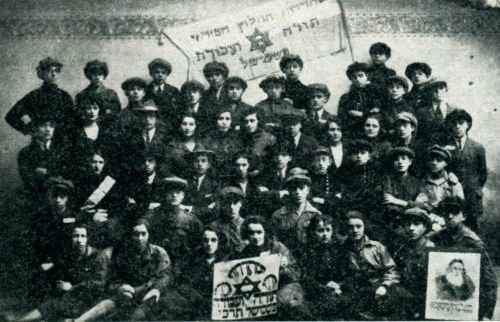[Page 252]
The Zionist Labor Movement in Przemyśl
by K. Y. Golan (Goldfarb)
“Red Przemyśl” – that was what many of its residents called our town. The workers' house, one of the largest buildings in town, towered over the north bank of the San river as the P.P.S. (the Polish Socialist Party) fortress and as a symbol of its power and status in the area. And indeed, it had great influence among the public, despite the fact that Przemyśl was not an industrial town. There were a number of Jews in the leadership of this Polish party and many circles of the Jewish population, although not members, supported it.
The leaders of the Polish Social-Democratic party, including the great Hermann Lieberman, declared war on Zionism as a reactionary and clerical movement.[i]
In this hostile environment, the idea of a Zionist labor movement barely made its way. Its first signs appeared at the same time as the establishment of the Zionist organization in Galicia and in our town.
The organizations “Ivri,”[sic] “Achva” and finally “Poalei Zion” became well established in Przemyśl. In 1905 a district committee of Poalei Zion operated in Przemyśl. At the first conference of academics from this movement, in 1909, a central board was elected, led by Yitzhak Kandel, and it was based in Przemyśl.
As the Poalei Zion movement weakened throughout Galicia, the Przemyśl branch also ceased to operate and only a few members remained connected to the center, who – after the unification with the “Hitachdut” – found their place in the Zionist-Socialist united party, “Hitachdut-Poalei-Zion.”
Echoes of the ideological agitation within the Zionist organization in Eastern Galicia, which arose under the influence of “Hapoel HaTzair” in Eretz Yisrael and “Tzeirei Zion” in Russia, reached Przemyśl too. After World War I, members of youth and intelligentsia circles spoke out against the conservatism in the Zionist organization and against its estrangement from Zionist activity. They began to fight for greater centralization of the activities for Eretz Yisrael, aliya and independent work, for learning Hebrew and for the progressive Zionist content.
These groups took on different forms and then discarded them, such as the national practice “Tzeirei Zion”, a Zionist radical-democratic group, a Zionist-Socialist national association which joined the Poel HaTzair organization in 1920 – “Tzeirei Zion”. The first to join the movement were members of the “Tzeirei Yehuda” society.
After the “Hitachdut” was removed from the Zionist organization in Galicia (1923), the movement organized as an independent Zionist party and at that time they established a branch in Przemyśl. The branch was directed by Haim Elias (in 1924 he was elected to the central committee of the Hitachdut in Eastern Galicia), who devoted his heart and soul to this movement his whole life. He dedicated many efforts and often sacrificed personal affairs. A short time after the unification with Poalei Zion, he moved to a group called “Hitachdut-anti-Ichud” [“anti-unification Hitachdut”], but later returned to his original point. Other notable leaders of the movement were Elisha Stein, chairman of the branch; Dr. Mordechai Schattner, chairman of the branch (now in Tel Aviv); Yosef Wolkstein-Ben-Yitzhak (member of the local committee in the Schiller group). Among the first pioneers who left their mark on the image of the local pioneering youth, were: the brothers Yitzhak and Herz Antmann, Berglas, Mordechai Kanner (now in Tel Aviv), Mahlberg, Yosef Weinberg (now in Jerusalem), Arie Kawe (now a teacher in Tel Aviv), Yeshaya Tafet.
The branch, which shared its club residence with the “Ivriya” on Mickiewicza Street, was attended mainly by
[Page 253]
youth from the lower classes. The activities centered around pioneering, disseminating the Hebrew language, working for the Keren Kayemet and for “Ezra.” Among the Keren Kayemet activists, Zvi Hauben was known for his dedication and accomplishments.
When the “Hitachdut” representatives in Galicia were elected to the Sejm, in the early 1920s (Dr. Abraham Silberstein, Zvi Heller, Dr. Kopel Schwartz, Dr. M. Bienenstock), the branch also expressed its opinions in matters of local policy – “The work of the present”, in the terminology of those days. This activity was conducted in the Przemyśl branch, as in the other sections of the movement, under constant doubts with regards to maintaining their priorities for Eretz Yisrael affairs.
|
|
The local committee of the Hitachdut
Sitting from left: first row: N. Miltau, Z. Hauben
Second row: J. Antmann, M. Kanner, H. Elias, J. Wolkstein, M. Weisinger, E. Stein
Standing from left: third row: Shpira, R. Rosenfeld, I. Goldfarb, H. Willner, B. Rottenberg, S. Antmann
Forth row: M. Eichenbaum, F. Tugendhaft, J. Rubin, M. Erbsmann, N. Patron, Z. Hering, Z. Horowitz |
The momentum of the branch activity greatly increased in 1937 after intelligentsia circles joined the movement, especially from among the ranks of teachers at the Hebrew gimnazjum. Since then, the branch's influence on the town's public life increased, and even went beyond its scope and contributed significantly to the labor movement in Galicia and beyond.
[Page 254]
From that group, I recall Benjamin Brettholz, Shmuel Wurm and Dr. Michael Weisinger-Ziv (now in Jerusalem). The latter was extremely influential on large circles of the Noar Halomed, who were perplexed in their oscillation between socialism, which was estranged from the reality of the Jewish people, and the old fashioned form of the Zionist “corporation”, which had become void of ideological content and of a living connection with Eretz Yisrael. Weisinger-Ziv found the way to reach the heart of the youth and brought them over to the ideals of practical Zionism with a social, and universally moral pathos.
Three people formed the first core of the society of gimnazjum students (1927): Klemens-Yisrael Goldfarb-Golan (now in Jerusalem), who was active in the society, in the branch, and later in the movement headquarters (the Boseliah secretariat, the Halutz center, member of the acting board of the party, general secretary in Eastern Galicia, representative to the Zionist Congresses); Shlomo Miltau, an activist in the society and the branch; and Josef Parnes, who was only with the movement for a short while (he is now a professor in the veterinarian department in one of the universities in Poland). In 1928, a group of high school students laid the foundations for a society of students, first called “Academic Gordonia” and later “The Society of Zionist-Socialist Academics.” At the height of its development, some 80 members belonged to the society in Przemyśl, gimnazjum graduates and students who studied at the universities in Poland and other countries. A group of student-pioneers was active within the society, many of whom are now in Israel. The Przemyśl branch was the largest of all the student societies in “Hitachdut-Poalei-Zion” and the Second National Conference was held in Przemyśl. The society published a single newsletter in Polish, “Nasze drogi.”
Many of the society activists took on central roles in the movement. Dr. Michael Weisinger-Ziv, the founder of the society and its first chairman, was elected to the national presidency of the party in Lvov, and later to the presidency of the party in Poland, a representative to the unification conference in Danzig[a] and one of the formulators of Zionist Socialist
[Page 255]
thought in Poland (see “Galician Chapters”, chapters on the history of the labor movement in Eastern Galicia,” by Dr. Nathan Melzer, p. 189).
Ze'ev (Zygmunt) Hering was the general secretary of the party in Galicia, editor of the newsletter “das freie wort”, representative to Zionist Congresses (now a member of the central committee of the executive of the general workers' organization). Mordechai Bauer was a member of the “Boseliah” secretariat, member of the party executive, a representative to Zionist Congresses (now in the Mishmar Hasharon group). Dr. Abraham Sternberg was general secretary of the party in Western Galicia, member of the central leadership of “Gordonia” (now in Tel Aviv). Activists in the student society and the party branch included: H. Augarten, Emil Engelhardt (died in Israel), Hela Arteg, H. Ornstein, Shmuel Bernstein (now in Jerusalem), Ansel Goldfarb, Sarah Hering-Hirsch (now in Haifa), Sarah Horszowski[b], Kopel Weisinger (later a leader of “Gordonia,” died in a work accident in Israel), Abraham Weiss, Dr. Ada Lichtbach-Bass (now in Tel Aviv), Matityahu Mark, Gina Sinkower-Margalit (now in Haifa),
|
|
The youth committee of the “Hitachdut”
Sitting from left, first row: Bauer, Kretzstein, Willner, S. Antmann, Horszowska, Singer, Lichtbach, Erbsmann, Frankfurter, Hering, Ernst, Eisenbruch, Kreppel
Second row: Krebs, Wolkstein, Rosenfeld, Rubin, Salzberg, Kanner, Goldblatt
Standing from left: Baumann, Hauben, Dinkes, Lichtbach, Felsen, Meller, Knoller, Eichenbaum, Kraus, Patron, Messner, Kessel, Z. Hering |
[Page 256]
Dr. Rozge Pier-Berler[c] (now in Brussels), Michael Frenkel (immigrated from Przemyśl to Argentine), Yitzhak Koenigsberg-Harel (now in Tel Aviv), A. Koenigsberg (now in Haifa), Kessel, Simcha Antmann (now a teacher in Jerusalem), the Konreich brothers.
The organizational framework expanded and in addition to “Gordonia”, about which there is a separate section, a branch of pioneering youth was established by the “Boseliah” party. One of its activists was Markus Dinkes-Wolfshaut (now in Paris). “HaOved” was an organization for purposes of aliya by craftsmen who, due to their age, could not be members of the “Halutz.” Mordechai Kanner, who led this organization, moved to the national secretariat of “HaOved”. There was also a society of high school students for commerce, “Kadima”, whose chairman was Jakob Bauman (now in Tel Aviv).
A youth council led by Yosef Rubin (now in Ramleh) was established for the purposes of coordination between the youth organizations in the branch.
Following the unification with Poalei Zion in 1933, a small group left the party and became affiliated with the “Anti-Ichud Hitachdut”, and on the other hand a number of Poalei Zion members joined, including activists of the united party such as Dr. Benjamin Teich – chairman of the branch, Dr. Moros Sobel, and Salz (now in Tel Aviv).
The “Hitachdut – Poalei Zion” branch, which was the second largest in Eastern Galicia, had over 300 active members. The club on Slowackiego Street bustled with members every evening, particularly young members. It held various organizational and educational activities, all based on volunteering. Investigations into the character and path of Zionism, international socialism and the Jewish question, the socialist basis of the party, self-realization and the political and economic activity in the Diaspora – all these were the topics of lectures and aroused frequent heated debates. There was also outreach activity among both the Jewish and the non-Jewish population of the area. Lectures, meetings and pamphlets published from time to time spoke out against the indifference and illusions in Diaspora life, and were characterized by the ideological strife with the Revisionists and the General Zionists on one side, and the left which was estranged from the Jewish people on the other. The activity of the “Halutz” and other aliya organizations, as well as in the national funds, was increased. The party's influence was manifested in its victories in the elections for Zionist Congresses. At the head of the election activity stood Josef Wolkstein-Ben-Yitzhak, who directed the propaganda campaigns and the organizational work, with untiring dedication and efficiency.
The branch was also successful in the arena of “work for the present.” Its representatives were elected to the municipal council (Dr. M. Schattner) and the Jewish community (Haim Elias). Serious efforts were made in the area of professional activity, and organizations of trade workers and clerks at private offices were founded, and even a sector of metal workers, the only one in the professional societies affiliated with “Hitachdut Poalei Zion” in Galicia. The P.P.S., which had long objected to Zionism, began to understand the historical significance of the Zionist labor movement as a solution for the Jewish question, for which it did not view itself as a real solution. It also became aware of the potential influence of the Zionist labor movement among the Jewish public. This shift in the P.P.S. approach enabled cooperation with “Hitachdut Poalei Zion” in various political and professional areas, and particularly in the fight against anti-Semitism in the framework of the committee against fascism and anti-Semitism.
These sparks of understanding and brotherhood between the local Polish workers and the Jewish masses, shone a brief ray of light before the darkness of the terrible annihilation which befell the Jewish of Przemyśl along with all Polish Jewry.
* * *
(Y.A.) In 1932 David Ben-Gurion visited Przemyśl and was the guest of “Gordonia.” When he was presented a photograph of his visit by Moshe Gabish (Mermelstein), in 1952, David Ben-Gurion responded: “My visit to Galicia is
[Page 257]
engraved in my heart, for there I saw masses of youth eager to make aliya to Israel, and upon my return from there I felt with greater force the imperative to act urgently to increase aliya, and I am not certain whether many of those with whom I met in the towns of Galicia are still alive and were able to make aliya. That was my only visit to Galicia, and for that reason any relic from that visit is so dear to me.”
|
|
| Ben-Gurion in Przemyśl, 1932 |
Original Footnote:
- See Dr. N. M. Gelber's book, A History of the Zionist Movement in Galicia, p. 738 – “In the Jewish propaganda in Galicia, the position of the social-democrats was discussed in an article by Dr. S. R. Landau, “Zionism or Social-Democratism” and by Shmuel Miesels in the pamphlet: “Zionist or Socialist” (1898 in German) (Y.G.), which proved the falsehood of the social-democratic claims and pointed to the national character of the Jewish workers, whose proper place was only in the ranks of the Zionist movement.” Back
Coordinator's Footnotes:
- Danzig (German) -- Gdańsk Back
- Horszowski – spelled הורשובסקי), even though it refers to a female. In the caption to a photo on the same page, the name spelling reflects the Polish feminine ending – Horszowska. Back
- Spelled: פייר-ברלר Back
[Page 258]
The Revisionist Movement (“HaTzohar”) in Przemyśl
by Dr. Jakob Schechter
The life of the Jewish youth in Przemyśl was always vibrant. The political conflicts were more prominent and acute among the various youth camps and parties in Przemyśl than perhaps in any other Galician town. Clearly, this multi-colored scene also included the presence of “The Tzohar Alliance”[1] – the Revisionist party, with its many organizations and extensions.
In his first great journey through Poland in 1926, Ze'ev Jabotinsky came through Przemyśl. The impression left by his memorable appearances in other towns and the influence of his charming and great personality, were deeply engraved on the memories of Przemyśl Jews. Those were days of keen arguments between the factions of the Zionist movement regarding “the final goal,” the “political offensive,” the expansion of “The Jewish Agency,” and all the other stirring problems which were presented on the stage of the Zionist political debate by the great spirit of Ze'ev Jabotinsky. The Zionist students, who were unified in “Agudath Herzl,” held lectures and symposiums which put forth the positions of the various parties, including the heads of the Revisionist party from Lvov and Kraków.
The “Tzohar Alliance” in Przemyśl was officially established in 1927. It was led by Zvi Freund (Amit) of blessed memory, Lipa Sima, a refugee from Russia, and others. The first “Betar” center was established and the first meetings were held by the founders of the popular youth organization “Menorah.” In 1928, the first regional congress was held, with the participation of representatives from the small branches in rural areas. From one particular location, the “representative” was in fact the only local member of the party, and his presence at the congress was intended to attest to the penetration of “the doctrine of the Betar leader” even in such remote locations.
|
|
| “Betar” group in Przemyśl |
[Page 259]
The events in Palestine in 1929, which seemed to confirm Jabotinsky's statements regarding the need to establish an armed Jewish force, gave the Revisionist party a renewed momentum in Przemyśl too. At that time, attorney Dr. Benjamin Weintraub joined the movement, and was appointed as its director. Over time, he became one of the most dedicated and zealous activists. He organized and managed the Betar district and was the district commander. The movement was also joined by Dr. Fischel Babad of blessed memory, a member of a well-known orthodox family in Przemyśl which was very influential, primarily in religious circles. Dr. Weintraub managed to make aliya as early as 1935 and is now a well-known attorney in Haifa. Dr. Babad was imprisoned by NKWD in 1939 and has not been heard of since.
During that period, Betar's strength increased significantly. Thanks to Dr. Weintraub's excellent connections, close contact was established between the Betar headquarters and the Polish military authorities. Training camps were conducted in Kunkowce, Jarosław and other places, where Polish officers trained the future combatants of the Jewish underground in Eretz Yisrael, teaching them guerilla tactics and use of arms.
The sense of pride and elation excited the Jewish population in the small towns, as they saw the bronzed young men, strong and courageous, in Betar uniforms with weapons in their hands, marching down the street to the amazement of the Polish anti-Semites. It was a “living denial” of the Polish prejudice, whereby the Jews were cowards and were incapable of waging an armed struggle for their freedom. Betar camps and marches also served as an excellent means of propaganda for the Revisionist party. From 1930 and onwards, throngs of Jewish youth joined the ranks of Betar in Przemyśl and the surroundings, and in the elections for the Zionist Congress in 1931, the Revisionist party came in second in the Przemyśl district. Its regional congresses were attended by dozens of representatives from all the towns and villages in the area.
|
|
| “Betar” in the Polish independence day parade near the City Hall |
[Page 260]
In 1932, an organization of Revisionist students was founded in Przemyśl, named “Emunah” [faith]. After a stormy meeting of “Agudath Herzl,” the Revisionist students withdrew from that general organization, under the leadership of this author, F. Babad, W. Astel and Y. Stremer. Thus, the last organizational partnership between general Zionists and Revisionists in Przemyśl was disbanded. The ideological struggle intensified, and laid the ideological ground for the final departure from the Zionist Organization.
When the “New Zionist Organization” was founded in 1935, Przemyśl was among the places in which this event engendered a true spiritual revolution. The new organization was joined by many new members, mainly from the local Zionist intelligentsia. It was joined, among others, by Dr. Steinhardt, one of the finest physicians in Przemyśl, a gentle-spirited and noble man; and Norbert Halpern, one of the spiritual leaders of “Agudath Herzl,” an exceptionally talented man, who once led the opposition to the cooperation with Revisionist students and caused their withdrawal from “Agudath Herzl.” But ultimately, he too moved to Tzohar, and was followed by many of his friends, to the national revolt camp.
When Jabotinsky came to the Jews of Poland with his “evacuation” notion, the idea was met with enthusiastic support among the masses in Przemyśl and the environs. When the war of destruction against the Jews broke out in 1939, the Revisionist party in Przemyśl reached its peak. Among the youth and the intelligentsia and among the masses, there was a recognition that indeed there is no future to the life of degeneration in the diaspora, and that there is no solution other than to join the great active struggle for the establishment of a Jewish state in our generation, the struggle led by Ze'ev Jabotinsky.
The days of the Shoah came and the dramatic tension of the ideological strife among Polish Jews subsided. In the destruction of Polish Jewry, thousands of Betar and Tzohar members from Przemyśl and the surrounding areas were killed. One of the most beautiful and interesting episodes in the history of the nation and the Zionist movement had ended – a living and vibrant manifestation of the spiritual and ideological struggle, and the search for the solution and redemption.
Translator's Footnote:
- The Hebrew name “Tzohar” is the acronym צהר, which stands for ha-tziyonut ha-revizyonistit – Revisionist Zionism. Back
[Page 261]
The History of “HaMizrachi” in Przemyśl
by A. Ben-Pazi (Goldberg)
Upon the establishment of the international “Mizrachi” in 5662[a] by Rabbi Reines of blessed memory, echoes of the event reached Galicia too, including our town of Przemyśl, which was in those days a town of chakhamim and writers, students of the Torah and the learned.
The Mizrachi idea was dear to the hearts of these Jews, who were steeped in love and longing for Zion and its holy places. They were naturally the potential material for the foundation of a local “Mizrachi” organization.
Due to a lack of organizational resources which characterized these circles, mostly from the merchant middle-classes, this did not occur until the end of the First World War. However, many of these people participated in general Zionist activities: the shekel campaigns, selling shares in the “Jewish Colonial Trust,” studying the Hebrew language, and so forth.
Their teacher, spiritual leader and central figure, who was treated with affection and respect, was Rabbi Gaon Gedalia Schmelkes of blessed memory, the town rabbi. Apart from being a Gaon in Torah and science, he was also blessed with a distinguished character. One of the outstanding people whose prominent personality forced even his rivals to treat him with respect and admiration. He was one of the first founders of the world Mizrachi.
This Gaon rabbi served as a 'pillar of cloud,' a guide for the population we mentioned previously, and they were proud of him. And in this way, a Mizrachi core was created in Przemyśl, not yet having a concrete organizational structure. This was in 5678[b], after the First World War.
When the Austro-Hungarian empire collapsed towards the end of the war, the national council (folksrat) was established in our town, composed of representatives from all the parties. Rabbi Moshe Katz, a respected talmid chacham, well-liked by the people, represented the Mizrachi party in this council. He was also elected chairman at the first Mizrachi meeting.
The few people we mentioned above were then joined by hundreds of Jews, including many Torah scholars and learned people. Apart from Rabbi Schmelkes, who was elected honorary chairman every year, some of the prominent members were Rabbi Shmuel Knoller, Rabbi Shmuel Brach[c], Rabbi Yehoshua Bakenrot, Rabbi Shimon Rappoport, M. Perlroth, Rabbi Yosef Frei[d], father of the well-known physicians, the Frei brothers in Tel Aviv, A. Kneppel, the author Kahane-Avrech, the living spirit of the party.
The Mizrachi in Przemyśl convened hundreds of scholarly Jews, deep-rooted Jews who were knowledgeable and well-versed in the Torah, polite men who were worthy of the glory of several communities.
Every Shabbat there were lectures in the Mizrachi auditorium on current affairs, or about the weekly portion, and they never needed to bring in external lecturers. The heart breaks as we recall that all those people were destroyed and are now gone; it is hard to find consolation for the loss of these dear souls and their blessed memories bring pain. We pray to be given their likes.
Apart from weekly lectures and the maintenance of a special prayer-house, the Mizrachi participated in all the general Zionist activities, especially in the work of Keren Hayesod, which was active among the middle class. In 1924, when the Keren Hayesod was founded in Przemyśl, under the presidency of Rabbi Abraham Haim Klagsbald, this author was appointed to manage the secretariat as a Mizrachi representative, and served in this capacity until 1930. In 1925, “Chalutz Mizrachi” [Mizrachi Pioneer] was also organized, with its center in Lvov. The Przemyśl branch was directed by D. Benari[e] (now in the Ministry of Education in Tel Aviv), who worked to train the religious youth in preparation for aliya.
[Page 262]
|
|
| A group of Mizrachi pioneers |
Until 1930 the Mizrachi organization in Przemyśl included the “Mizrachi Youth,” whose representatives were included in the general committee. However, as the number of young members in the party increased, they presented more specific demands, which were not part of the general Mizrachi framework, such as Hebrew lessons, lectures, and so forth. As the demand for aliya increased among the youth, along with the question of hachsharah,[1] the need emerged for a youth organization in a special framework. And so the Mizrachi-affiliated movement named “Torah ve'Avoda” [Torah and Work] was founded, its main purpose being to organize the religious youth and provide training for aliya.
The Przemyśl organization of “Torah ve'Avoda” also served, naturally, as a kind of secondary center – after the Lvov center – for all the “Torah ve'Avoda” organizations from the nearby villages around Przemyśl.
Przemyśl hosted meetings of the regional committees from time to time, and was also the site of a central hachsharah battalion from the entire area. The local party offered moral assistance and material support by supplying work.
Before making aliya in 1936, this author served as chairman of the above organization.
My heart goes out to that dear and sacred youth. Their longings, dreams and hopes were all for aliya. We did not succeed, nor did they, and their bones are scattered in the defiled land. Few of them were saved and found refuge in aliya. They are located in various parts of Israel, in agricultural settlements and work places. Most of them died in the Shoah. May the Lord avenge their blood.
And finally, I must present a memorial to a dear soul, Jakob Alweiss[f], may the Lord avenge his blood. A sweet young man, learned and God-fearing. Son of a poor widow, whom he supported. At daytime he was an artisan, and at night he studied Torah. Modest and shy, he nonetheless stood out in his activism at the branch, of which he was secretary, and particularly in assisting any lonely members who needed help. His dedication served as a role model for all his friends, who loved and admired him.
[Page 263]
Before I made aliya I tried to influence him to take over the leadership of the organization in my place. Being modest, he strongly objected.
He preferred the work of the common soldier, which he liked. But finally he gave in to me and, with the agreement of all the members, was elected chairman of the branch.
After I made aliya we corresponded frequently, and how happy he was when he informed me of the development of the organization or of some important activity which he had initiated and seen through. When the war broke out, while he was already planning to make aliya, the Nazis, cursed be they, entered the town and, as is known, their first step was to be given lists of all the parties and their chairmen. And thus they were given his name too, and he was one of the first to be executed.
May the Lord avenge his blood and may his soul be bound in the bond of eternal life, with all the martyrs of the nation.
|
|
| The “Torah ve'Avoda” organization in Przemyśl |
Translator's Footnote:
- Hachshara. Lit. “training” in Hebrew. This term referred to the training given to young people before they made aliya. It consisted mainly of gaining practical experience in agriculture, as well as mental and physical readiness for life in Israel. Back
Coordinator's Footnotes:
- This refers to Hebrew calendar and corresponds to 1901/1902 in the secular (Gregorian) calendar Back
- This corresponds to 1917/1918 in the secular calendar Back
- Brach, בראך Back
- Frei, פריי Back
- Benari, בנארי Back
- אלויס Back
This material is made available by JewishGen, Inc.
and the Yizkor Book Project for the purpose of
fulfilling our
mission of disseminating information about the Holocaust and
destroyed Jewish communities.
This material may not be copied,
sold or bartered without JewishGen, Inc.'s permission. Rights may be
reserved by the copyright holder.
JewishGen, Inc. makes no representations regarding the accuracy of
the translation. The reader may wish to refer to the original material
for verification.
JewishGen is not responsible for inaccuracies or omissions in the original work and cannot rewrite or edit the text to correct inaccuracies and/or omissions.
Our mission is to produce a translation of the original work and we cannot verify the accuracy of statements or alter facts cited.
 Przemyśl, Poland
Przemyśl, Poland
 Yizkor Book Project
Yizkor Book Project
 JewishGen Home Page
JewishGen Home Page
Yizkor Book Director, Lance Ackerfeld
This web page created by Osnat Ramaty
Copyright © 1999-2025 by JewishGen, Inc.
Updated 22 Aug 2025 by LA
